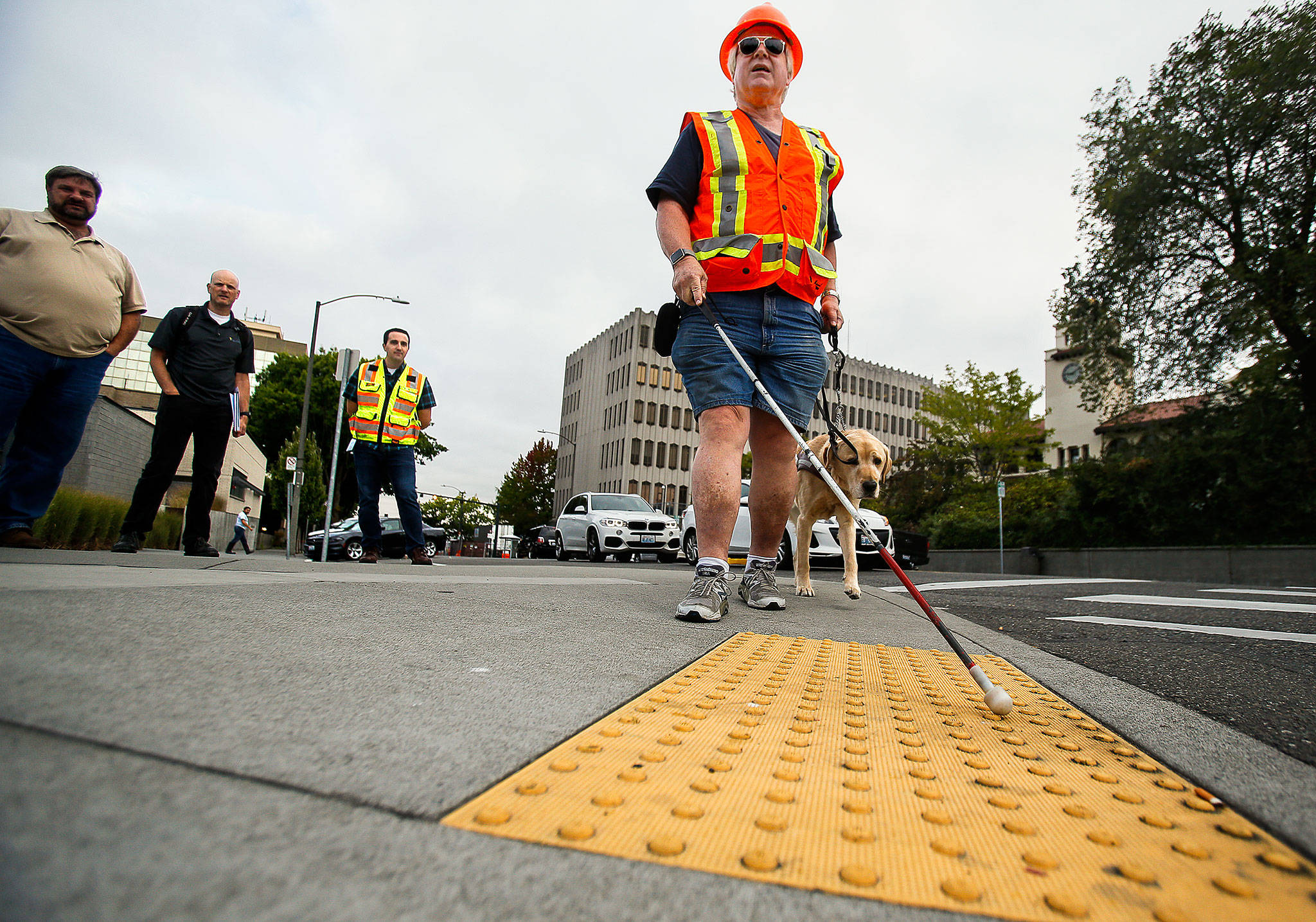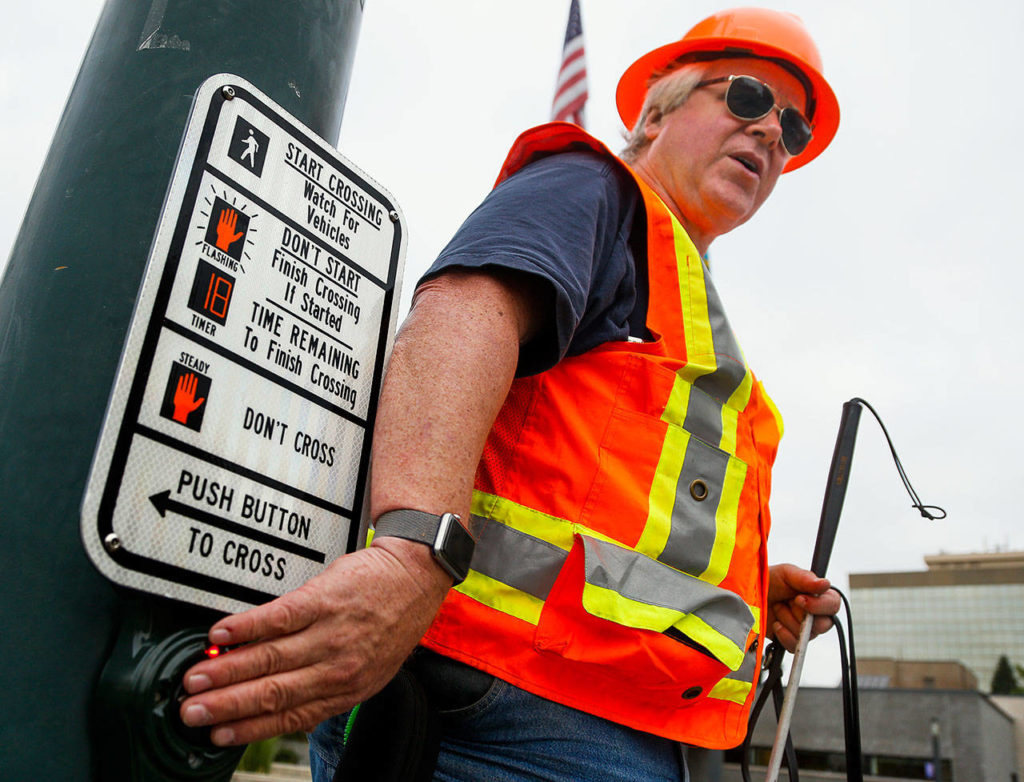EVERETT — Making it safe for a person with disabilities to cross a street is no straight line.
There are 30 standards to meet just for a basic curb ramp, such as the degree of its slope and the type of surface.
Local governments are taking stock of how well their sidewalks and crosswalks meet such rules, and they face a daunting task ahead with billions of dollars worth of work that will take decades to complete.
That’s where George Basioli steps in.
The Edmonds man, who is blind, led a walking tour of downtown Everett for area public works employees and contractors Friday. The tour was part of a one-day training workshop by Snohomish County to help participants better understand the standards for public right-of-way facilities — sidewalks, crosswalks, bus stops — under the Americans with Disabilities Act.
Basioli was there to show them the “why” of all the rules.
“There’s been extreme improvement in the last five years,” he said. “But people don’t know how the system works if they don’t see it hands-on.”
The walking tour is a new piece to the training workshop, which the county has offered at least once a year since 2014. Basioli also helped with a walking tour in August.
The training was born from a federally mandated self-evaluation program the county started in 2011.
During that study, the county found that 93 percent of its curb cuts weren’t up to snuff. Neither were 62 percent of sidewalks, 60 percent of crosswalk push buttons or 90 percent of bus stops, according to a 2016 story in The Daily Herald.
Some of the problem areas predated the ADA. Others were updated, but to old standards. Some simply got the standards wrong.
“It wasn’t just the county in this predicament. It was pretty much every local agency that I know of. We were all in this same boat together,” county engineer Ryan Peterson said.
One problem? A lack of training.
The county has since seen its own compliance increase.
For example, in 2016 there were 156 sidewalk ramps constructed in unincorporated Snohomish County. Of these, six had measurements that were slightly off. That’s 12 measurements out of 4,600, Peterson noted. Much better than previous years.
“We made big strides, and I think our training has a lot to do with that,” he said.
But there’s still a long way to go.
A big to-do list
Snohomish County estimates there are $1 billion worth of facilities that are not compliant, including about 10,000 curb ramps and 400 miles of sidewalk. They fix things as they go, but staff also are working on a list of priority projects with help from an advisory group. They expect to have a draft plan later this month. The goal is to get the highest priorities fixed within 12 years.
Local cities are going through the same process.
Some, like Marysville, have yet to get started. That city intends to start in 2019.
Others, like Edmonds, have finished. The city’s study, published in 2017, resulted in a wide range of recommendations, including avoiding the use of “handicap” in policy documents and adding sidewalks to snow and ice control measures.
Complaints from Edmonds residents will help steer future improvements. Locations that serve public facilities, clinics, bus stops and other high-traffic areas also will get higher priority. A separate pedestrian crossing project will upgrade ramps at nine locations across the city in 2019. An ADA curb ramp program addresses a handful of ramps each year.
Staff are looking for grants to do more, engineer Bertrand Hauss said. He’d like to form a city crew focused solely on curb ramps, which would be cheaper than hiring out the work.
Everett is in the midst of its study.
Public works staff are working on their final plan of attack. The to-do list is a long one: 60 percent of more than 3,480 curb ramps, and roughly 7 in 10 crosswalk buttons, just to give two examples.
“Right now that list is in the form of a foot-high pile of paper,” city engineer Ryan Sass said.
How much would it cost to fix it all?
“I’m pretty sure that number would start with a ‘B’, ” Sass said.
Moving targets
Like other cities, Everett had already been chipping away at these problems. City concrete crews spend $1.4 million per year on new sidewalks, curb ramps and driveways, for example. The crew averages 60 to 80 new ramps per year, most of them replacements.
The ADA standards have evolved over time.
The act was passed in 1990. The right-of-way recommendations came two years later, with updates in 2002, 2005, 2011.
Technically speaking, the standards are still considered in flux.
That’s brought a change in perspective, Sass said.
“We thought, OK, we’ll figure out what we have to do and get it done,” he said. “But what we’ve come to realize over time is the ADA isn’t really like that. It’s an evolving standard, and we’re always learning how to accommodate people and their varying abilities. We’re going to make great strides … But it’s not something you ever get done with.”
Moving forward
Basioli has experienced that evolution.
When he first started crossing Highway 99, there were no sidewalks or audible signals on the pedestrian button to let him know when it was safe. Tones were added in the early 2000s. And then around Christmas 2017, the buttons were upgraded with signs and a recorded voice.
Walking to the store or a meeting still isn’t the simplest thing, Basioli said, even with a guide dog. “But it’s a lot easier than it was 30 years ago.”
Advising local governments on that work has helped Basioli through his own struggles, he said.
Basioli was born blind in one eye and partially blind in the other. He completely lost his sight in 2003.
“I used to wake up in the morning crying, wondering, ‘What I am going to do today?’ I had to learn how to accept it,” he said.
He got connected to folks working at the county. And he’s now co-chair of the advisory committee, helping plan fixes.
“I realized I can make it better for people coming up behind me,” he said.
He’s encouraged by the progress and eager to spur more.
“Every place, it’s getting better, because people are starting to understand,” he said.
Melissa Slager: streetsmarts@heraldnet;com, 425-339-3432.
Talk to us
> Give us your news tips.
> Send us a letter to the editor.
> More Herald contact information.



























